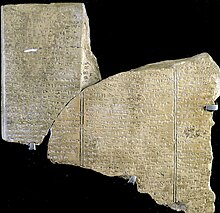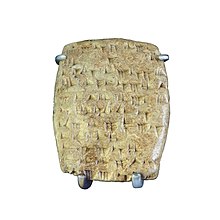
The Ugaritic texts are a corpus of ancient cuneiform texts discovered in 1928 in Ugarit (Ras Shamra) and Ras Ibn Hani in Syria, and written in Ugaritic, an otherwise unknown Northwest Semitic language. Approximately 1,500 texts and fragments have been found to date. The texts were written in the 13th and 12th centuries BC.
The most famous of the Ugarit texts are the approximately fifty epic poems; the three major literary texts are the Baal Cycle, the Legend of Keret, and the Tale of Aqhat. The other texts include 150 tablets describing the Ugaritic cult and rituals, 100 letters of correspondence, a very small number of legal texts (Akkadian is considered to have been the contemporary language of law), and hundreds of administrative or economic texts.
Unique among the Ugarit texts are the earliest known abecedaries, lists of letters in alphabetic cuneiform, where not only the canonical order of the later Phoenician script is evidenced, but also the traditional names for letters of the alphabet.
Other tablets found in the same location were written in other cuneiform languages (Sumerian, Hurrian, and Akkadian), as well as Egyptian and Luwian hieroglyphs, and Cypro-Minoan.
Discoveries
| Ugarit |
|---|
 |
| Places |
| Kings |
| Culture |
| Texts |

Initial discovery
On excavation of the city of Ugarit, found accidentally in 1928–29 at Ras Shamra, Syria, several deposits of cuneiform clay tablets were found; all dating from the last phase of Ugarit, around 1200 BC. The texts were found to be written in an otherwise unknown Northwest Semitic language. Other tablets found in the same location were written in other cuneiform languages (Sumerian, Hurrian and Akkadian), as well as Egyptian and Luwian hieroglyphs, and Cypro-Minoan.
The tablets were found in diplomat, (Rapanu’s) private palace library, and his temple library. His libraries were a rarity of the times. His libraries at Ugarit contained diplomatic, legal, economic, administrative, scholastic, literary and religious texts.
1958 excavations
During excavations in 1958, yet another library of tablets was uncovered. These were, however, sold on the black market and not immediately recovered. The "Claremont Ras Shamra Tablets" are now housed at the Institute for Antiquity and Christianity, School of Religion, Claremont Graduate University, Claremont, California. They were edited by Loren R. Fisher in 1971.
1973 excavations
After 1970, succeeding Claude Schaeffer were Henri de Contenson, followed by Jean Margueron, Marguerite Yon, then Yves Calvet and Bassam Jamous, who since 2005 has held the office of Director General of Antiquities and Museums. In 1973, an archive containing around 120 tablets was discovered during rescue excavations.
1994 excavations
In 1994 more than 300 further tablets dating to the end of the Late Bronze Age were discovered within a large ashlar masonry building.
Notable texts


Approximately 1,500 texts and fragments have been found to date, all of which have been dated to the 13th and 12th centuries BC. The most famous of the Ugarit texts are the approximately fifty epic poems. The most important literary document recovered from Ugarit is arguably the Baal Cycle, describing the basis for the religion and cult of the Canaanite Baal; the two other particularly well known texts are the Legend of Keret and the Tale of Aqhat. The other texts include 150 tablets describing the Ugaritic cult and rituals, 100 letters of correspondence, a very small number of legal texts (Akkadian is considered to have been the contemporary language of law), and hundreds of administrative or economic texts. Some other tablets include scribal exercises; some of them are unique for being the earliest known abecedaries, lists of letters in alphabetic cuneiform, where the canonical order of Hebrew-Phoenician script is evidenced, and one of them might even indicate the traditional names for letters of the alphabet.
The tablets have been used by scholars of the Hebrew Bible to clarify Biblical Hebrew texts and have revealed ways in which the cultures of ancient Israel and Judah found parallels in the neighboring cultures. The tablets reveal parallels with Israelite practices described in the Bible; for example, Levirate marriage, giving the eldest son a larger share of the inheritance, and redemption of the first-born son were practices common to the people of Ugarit as well.
See also
Resources
- Manfried Dietrich; Oswald Loretz; Joaquín Sanmartín (1995). The Cuneiform alphabetic texts: from Ugarit, Ras Ibn Hani and other places ("CAT"). Ugarit-Verlag. ISBN 978-3-927120-24-2. – the second edition (and the first in English) of the standard collection of Ugaritic texts
- Manfried Dietrich (1976). Die keilalphabetischen Texte aus Ugarit: einschließlich der keilalphabetischen Texte außerhalb Ugarits ("KTU"). Butzon & Bercker. – the first edition of the standard collection of Ugaritic texts
- Huehnergard, John (2012). An Introduction to Ugaritic. Hendrickson Publishers. ISBN 978-1-59856-820-2.
- Schniedewind, William; Hunt, Joel H. (2007). A Primer on Ugaritic: Language, Culture and Literature. Cambridge University Press. ISBN 978-1-139-46698-1.
References
- ^ Aaron Demsky, 1977. "A Proto-Canaanite Abecedary dating from the period of the Judges and its implications for the history of the Alphabet", Tel Aviv 4:47ff.
- Berman, Ruth Aronson (2005-01-24). Perspectives on Language and Language Development: Essays in Honor of Ruth A. Berman. Springer Science & Business Media. ISBN 978-1-4020-7903-0.
- Encyclopedia of Language and Linguistics. Elsevier. 2005-11-24. ISBN 978-0-08-054784-8.
- Caquot, Andre; Sznycer, Maurice (2023-08-14). Ugaritic Religion. BRILL. ISBN 978-90-04-66447-0.
- ^ Huehnergard 2012, p. 3.
- Loren R. Fisher, The Claremont Ras Shamra Tablets, Loyola Press, 1972, ISBN 978-88-7653-248-1
- ^ Henri de Contenson, Préhistoire de Ras Shamra, Ras Shamra-Ougarit VIII, 2 volumes, ERC, 1992; Marguerite Yon, The City of Ugarit at Tell Ras Shamra, Eisenbrauns, 2004, ISBN 1-57506-029-9 (Translation of La cité d'Ugarit sur le Tell de Ras Shamra 1979)
- Malbran-Labat, F. 1995. Les archives de la maison d'Ourtenou, Comptes rendus des séances de l'Académie des Inscriptions et Belles-Lettres, pp. 443–451 and La découverte épigraphique de 1994 à Ougarit, Studi micenei ed egeo-anatolici 36: 103–11
- Schniedewind & Hunt 2007, pp. 26, 117: "Three major literary texts—the Baal Cycle, the Keret Legend, and the Tale of Aqhat—have been discovered in Ugarit. These materials form the major, and perhaps the most significant, portion of the Ugaritic alphabetic corpus... Most of the major literary texts from Ugaritic are in the form of narrative poems. Included here are selections from the three most famous poems: the Baal Cycle, the Keret Epic, and the Story of Aqhat."
- In Ugaritic: KTU 2.1–2.83
- In Ugaritic: KTU 3.1–3.10
- In Ugaritic or Ugaritic and Akkadian: KTU 4.1–4.792
- KTU 5.1–5.25
- Demsky, Aaron (1977). "A Proto - Canaanite Abecedary Dating from the Period of the Judges and its Implications for the History of the Alphabet". Tel Aviv. 4 (1–2): 15. doi:10.1179/033443577788497786. ISSN 0334-4355.
- Greenstein, Edward L. (November 2010). "Texts from Ugarit Solve Biblical Puzzles". Biblical Archaeology Review. 36 (6): 48–53, 70. Retrieved 22 April 2017.
- Schniedewind & Hunt 2007, pp. 28–30.
- ^ Huehnergard 2012, p. 6.